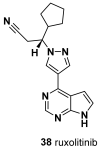Recent Advances in Drug Discovery for Triple-Negative Breast Cancer Treatment
- PMID: 38005235
- PMCID: PMC10672974
- DOI: 10.3390/molecules28227513
Recent Advances in Drug Discovery for Triple-Negative Breast Cancer Treatment
Abstract
Triple-negative breast cancer (TNBC) is one of the most heterogeneous and aggressive breast cancer subtypes with a high risk of death on recurrence. To date, TNBC is very difficult to treat due to the lack of an effective targeted therapy. However, recent advances in the molecular characterization of TNBC are encouraging the development of novel drugs and therapeutic combinations for its therapeutic management. In the present review, we will provide an overview of the currently available standard therapies and new emerging therapeutic strategies against TNBC, highlighting the promises that newly developed small molecules, repositioned drugs, and combination therapies have of improving treatment efficacy against these tumors.
Keywords: PARP; antibody drug conjugates; cancer; combination therapy; drug resistance; inhibitors; kinases; microtubules; triple-negative breast cancer.
Conflict of interest statement
The authors declare no conflict of interest.
Figures





















Similar articles
-
Targeted Therapies for Triple-Negative Breast Cancer.Curr Treat Options Oncol. 2019 Nov 21;20(11):82. doi: 10.1007/s11864-019-0682-x. Curr Treat Options Oncol. 2019. PMID: 31754897 Review.
-
The treatment landscape of triple-negative breast cancer.Med Oncol. 2024 Aug 29;41(10):236. doi: 10.1007/s12032-024-02456-9. Med Oncol. 2024. PMID: 39210220 Review.
-
Biology and Management of Patients With Triple-Negative Breast Cancer.Oncologist. 2016 Sep;21(9):1050-62. doi: 10.1634/theoncologist.2016-0067. Epub 2016 Jul 11. Oncologist. 2016. PMID: 27401886 Free PMC article. Review.
-
Advances in small-molecule drug discovery for triple-negative breast cancer.Future Med Chem. 2015;7(15):2019-39. doi: 10.4155/fmc.15.129. Epub 2015 Oct 23. Future Med Chem. 2015. PMID: 26495746 Review.
-
Kinase inhibitors for precision therapy of triple-negative breast cancer: Progress, challenges, and new perspectives on targeting this heterogeneous disease.Cancer Lett. 2022 Oct 28;547:215775. doi: 10.1016/j.canlet.2022.215775. Epub 2022 Jun 3. Cancer Lett. 2022. PMID: 35667515 Review.
Cited by
-
IBCar: Potent Orally Bioavailable Methyl N-[5-(3'-Iodobenzoyl)-1H-Benzimidazol-2-yl]Carbamate for Breast Cancer Therapy.Cancers (Basel). 2025 Jul 30;17(15):2526. doi: 10.3390/cancers17152526. Cancers (Basel). 2025. PMID: 40805221 Free PMC article.
-
MALSU1-mediated regulation of mitochondrial function governs proliferation and doxorubicin resistance in triple-negative breast cancer cells.Mol Cell Biochem. 2025 Feb;480(2):1197-1207. doi: 10.1007/s11010-024-05053-6. Epub 2024 Jun 19. Mol Cell Biochem. 2025. PMID: 38896203
-
FEN1 Inhibition as a Potential Novel Targeted Therapy against Breast Cancer and the Prognostic Relevance of FEN1.Int J Mol Sci. 2024 Feb 9;25(4):2110. doi: 10.3390/ijms25042110. Int J Mol Sci. 2024. PMID: 38396787 Free PMC article.
-
Epithelial-mesenchymal plasticity in cancer: signaling pathways and therapeutic targets.MedComm (2020). 2024 Aug 1;5(8):e659. doi: 10.1002/mco2.659. eCollection 2024 Aug. MedComm (2020). 2024. PMID: 39092293 Free PMC article. Review.
-
A genotype-to-drug diffusion model for generation of tailored anti-cancer small molecules.Nat Commun. 2025 Jul 1;16(1):5628. doi: 10.1038/s41467-025-60763-9. Nat Commun. 2025. PMID: 40593549 Free PMC article.
References
-
- Jung S., Spiegelman D., Baglietto L., Bernstein L., Boggs D.A., van den Brandt P.A., Buring J.E., Cerhan J.R., Gaudet M.M., Giles G.G., et al. Fruit and Vegetable Intake and Risk of Breast Cancer by Hormone Receptor Status. J. Natl. Cancer Inst. 2013;105:219–236. doi: 10.1093/jnci/djs635. - DOI - PMC - PubMed
-
- Lehmann B.D., Jovanović B., Chen X., Estrada M.V., Johnson K.N., Shyr Y., Moses H.L., Sanders M.E., Pietenpol J.A. Refinement of Triple-Negative Breast Cancer Molecular Subtypes: Implications for Neoadjuvant Chemotherapy Selection. PLoS ONE. 2016;11:e0157368. doi: 10.1371/journal.pone.0157368. - DOI - PMC - PubMed
Publication types
MeSH terms
Grants and funding
LinkOut - more resources
Full Text Sources

